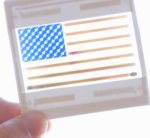University of Michigan (U-M) scientists have invented a transparent, coloured solar cell that could turn windows, shades and billboards into solar energy collectors.
The U-M team designed a palm-sized coloured solar cell decorated like the American flag – complete with stars and stripes.
“Today, solar panels are black and the only place you can put them on a building is the rooftop. And the rooftop of a typical high-rise is so tiny,” said Jay Guo, professor of electrical engineering and computer science, mechanical engineering, and macromolecular science and engineering at U-M.
“We think we can make solar panels more beautiful – any colour a designer wants. And we can vastly deploy these panels, even indoors.”
The team believe they have created a world-first in photovoltaics, and are working hard on improving the efficiency of their coloured cell.
Traditional black solar panels are able to absorb light from the entire visible spectrum, returning efficiency levels of around 25 percent. Other transparent and coloured solar technology like dye-sensitised cells, whereby organic solar material is sprayed or printed onto glass, offer returns of around 10 percent.
U-M’s coloured solar cell contains no dyes or internal structures. The cell contains a layer of amorphous silicon engineered to absorb certain wavelengths of light but to reflect others, meaning the viewer sees reflected blue light while red light is being captured and converted to energy, or vice versa.
To create the different colours seen in the American flag solar panel, they varied the thickness of the semiconductor layer of amorphous silicon in the cells. The blue regions are six nanometres thick while the red is 31 (the team also made green, but that colour isn’t in the flag).
An advantage of this approach means the solar panel does not change colour when seen from different angles; a sign, according to Guo, the device is capturing the same amount of sunlight regardless of its position in the sky. It also designs and colour schemes can be “locked in” to each panel.
“Solar energy is essentially inexhaustible, and it’s the only energy source that can sustain us long-term,” Guo said. “We have to figure out how to use as much of it as we can.”
The work has been published online in Scientific Reports.












































